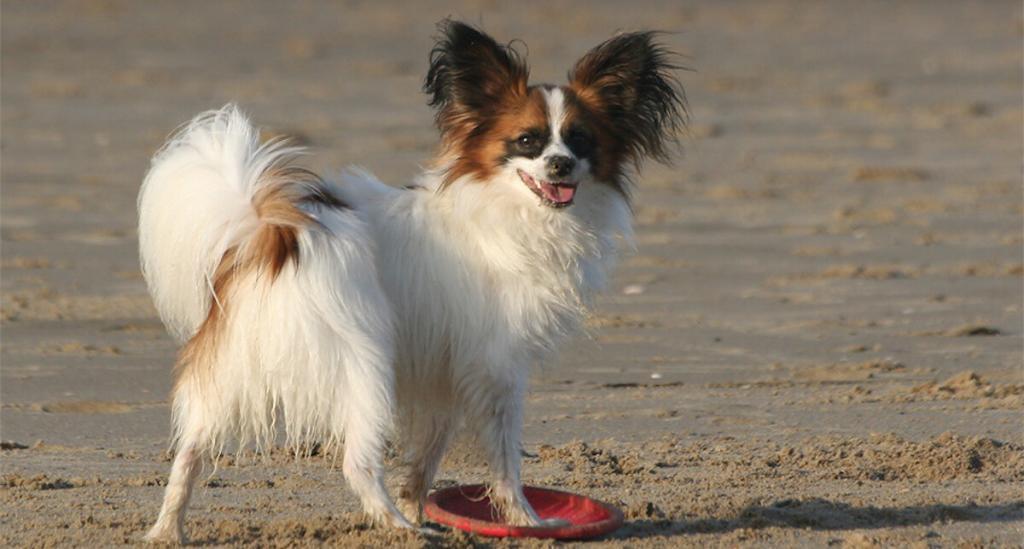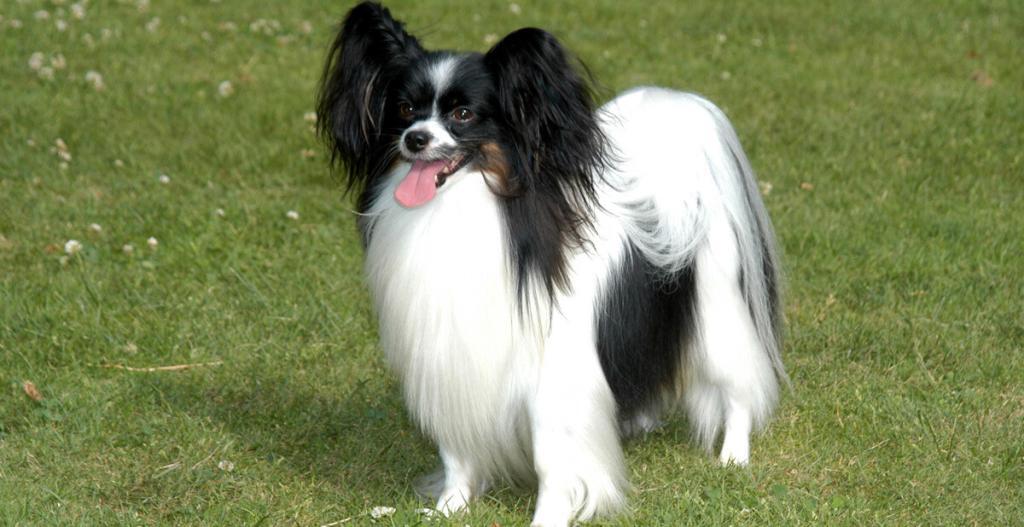You might believe that the Papillon, with its flamboyant ears and dainty frame, is nothing more than a living, breathing accessory designed to grace the laps of the rich and famous. Yet, this breed is far more than just a pretty face.
With a spirited and affectionate temperament, Papillons are known to be as agile in mind as they are on their petite feet. You’d be surprised by their intelligence and eagerness to learn; these dogs are ornamental and adept at obedience and agility challenges.
If you’re considering a companion that is both a visual delight and a testament to the adage ‘brains over brawn,’ you may be captivated by the multifaceted nature of these so-called butterfly dogs. Stick around, and you’ll uncover why the Papillon could flutter into the heart of your home and, perhaps, even teach you a few tricks along the way.
- Noise Level
- Energy
- Sociability
- Trainability
- Care
- Health
Overall
Summary
Papillons are known for their moderate noise levels, high energy, exceptional sociability, high trainability, moderate care needs, and good health.
Papillon: Traits, Temperament, and Care Guide
The Papillon, with its distinctive butterfly-like ears, exhibits a lively and affectionate temperament. It is both a delightful companion and an agile learner, thus requiring attentive care and consistent training to thrive.
As one of the smartest dog breeds, your Papillon’s high energy and quick wit demand engaging obedience training. This ensures they are well-rounded family dogs. Despite being a toy breed, the Papillon’s ears that give them their name aren’t just for show; they symbolize their alert and responsive nature.
A diet of 1/4 to 1/2 cup of high-quality dry food daily, regular grooming, and dental care will keep them in top condition. It is important to be aware of potential health issues. However, with proper care, the Papillon makes a great companion, ready to join your family with their unique blend of charm and intelligence.
Exploring the Characteristics of the Papillon
Having established the Papillon’s basic care requirements, let’s examine the breed’s specific traits. Their small stature, typically standing 8-11 inches tall and weighing 4-8 pounds, contributes to their lifespan of 12-15 years. Members of the toy spaniels, the Papillon—French for ‘butterfly’—owes its name to the breed’s distinctive erect, fringed ears resembling butterfly wings.
| Trait | Description | Emotional Significance |
|---|---|---|
| Size | Small, delicate | Intimate companionship |
| Lifespan | 12-15 years | Long-term bond |
| Ears | Butterfly-like | Unique beauty |
| Coat | Long, silky | Tactile pleasure |
| Temperament | Happy, outgoing | Joyful interactions |
Papillons need regular grooming and dental care, and they thrive when they participate in dog sports—showcased at events like the World Dog Show—demonstrating their agility and intelligence. The Papillon Club of America recognizes their adaptability, while their Continental Toy Spaniel roots, also known as Epagneul Nain, emphasize their historical charm.
Papillon: A Comprehensive Profile and Guide
You’re about to explore the full scope of the Papillon, a breed distinguished by its longevity and miniature stature.
Consider their history of companionship in European courts, which shapes their social and affectionate nature.
While they exhibit robust health, attention to their specific vulnerabilities, such as patellar luxation, is imperative for their well-being.
Everything You Need to Know
Delving into the world of the Papillon, you’ll discover a breed marked by its distinctive butterfly-like ears, small stature, and a lifespan that can extend well beyond a decade. Whether you’re considering a puppy or an adult dog, understanding the characteristics of small dogs like the Papillon is crucial for creating a nurturing environment.
- Traits:
- Ears: Large, upright with fringed hair resembling butterfly wings.
- Size: Among toy breeds, known for being sprightly lap dogs.
- Coat: Long fur requiring regular grooming to maintain its silky texture.
- Health and Care:
- Patellar Luxation: A common condition; preventive care is important.
- Energy Level: High; necessitates engaging training methods to keep them stimulated.
- Training and Socialization:
- Puppies: Early socialization is key for a well-adjusted dog.
- Adult Dogs: Adaptable with consistent, positive reinforcement techniques.
As a Papillon enthusiast, you’re joining a community that values these vivacious small dogs’ companionship and unique presence.

Discovering the Temperament
When considering a Papillon as a companion, it’s essential to understand that their temperament is as vibrant and varied as the patterns on their butterfly-like ears. As a butterfly dog, the Papillon thrives on mental stimulation and is remarkably easy to train, given their high intellect. However, they may exhibit a stubborn streak requiring a consistent and patient approach. These traits make them superb family pets, as they exude an attitude toward life that’s both joyful and inquisitive.
Despite their small size, don’t mistake them for a typical lap dog; they’re active and need regular exercise to maintain their health. Early socialization can ward off potential health problems by fostering a well-rounded disposition. This proactive approach ensures that your Papillon remains a happy and affectionate family member.
Papillon: Is It a Good Fit for Families?
You might wonder if the Papillon, with its vibrant personality and small stature, aligns well with the dynamics of family life. Observationally, their high adaptability and affectionate nature suggest they can integrate seamlessly into a family setting, thriving on interaction and play.
It’s crucial, however, to consider their interactions with children and other pets, ensuring supervision to foster a safe and harmonious environment.
Assessing Papillon’s Compatibility with Families and Kids
Assessing Papillon’s compatibility with families and kids reveals that this breed’s cheerful disposition and intelligence make them an excellent addition to households that can offer attentive care and lively interaction.
- Family Dynamics
- Children: The Papillon’s affectionate nature means they generally love children and enjoy playing with them, but kids must be taught to handle this small dog gently.
- Apartment Living: Their compact size allows for comfortable living even in small apartments, making the Papillon an adaptable family member in urban settings.
- Activity Needs: With a moderate to intense activity level, they fit well into active family lifestyles.
Papillon Apartment Living Suitability
Despite their diminutive stature, Papillons possess remarkable adaptability to apartment living. They thrive in cozy indoor environments when provided with adequate exercise and stimulation. As a toy breed, this tiny dog is an ideal companion for apartment dwellers, capable of remaining healthy and happy in smaller spaces. When considering a Papillon, ensuring they aren’t left alone for extended periods is essential, as their social nature craves interaction.
The Papillon is a great choice for those seeking a pet that melds well with the apartment lifestyle. Papillon owners can keep their butterfly-eared friends content by engaging in regular indoor playtime and brisk walks.
In small breeds, the Papillon is among the best choices for those desiring a vibrant and affectionate addition to their urban home.
Papillon Obedience Essentials
Employing positive reinforcement techniques, such as treats and play, is foundational for effective Papillon training.
Early socialization shapes their adaptable behavior, while crate training provides a sense of security and aids in housebreaking.
Given their high intelligence, Papillons respond well to consistent training, pivotal in their obedience and overall well-being.
Effective Training Strategies
To maximize the potential of a Papillon’s obedience, incorporate positive reinforcement methods such as treats and playtime into your training routine. Recognizing the traits and temperament of your Papillon puppy is essential; their intelligence makes them ideal candidates for dog training. They excel in agility or rally and may even shine in obedience competitions if trained with consistency and patience.
| Strategy | Benefit |
|---|---|
| Positive Reinforcement | Encourages desired behaviors; builds confidence |
| Consistent Schedule | Establishes routine; prevents confusion |
| Early Socialization | Promotes adaptability; love children and adults alike |
| Regular Grooming | Prevent matting; reinforces handling acceptance |
Effective training strategies regularly foster a well-behaved Papillon that thrives among family, including small children. With the right approach, you’ll deepen your bond and enjoy the full, vibrant expression of your Papillon’s personality.
Exercise and Grooming Needs
While Papillons thrive on energetic play and routine exercise, they also require attentive grooming to maintain their distinctive coats and overall health. As one of the more active smaller dogs, keeping your dog running around is crucial. Two to three daily walks will satisfy their exercise needs and help prevent common health issues like weight gain. Even in hot weather, Papillons fare well, though in the cold, they may need extra care.
Grooming is equally important for these best dog contenders. Their long, flowing coats need brushing two to three times a week to prevent mats. Please pay particular attention to their drop ears, which require regular cleaning to avoid infections. Remember, consistent dental care is also vital to their well-being.

Health Considerations
When considering a Papillon’s health, it’s important to note that they’re susceptible to genetic conditions such as patellar luxation and progressive retinal atrophy.
You’ll find that consistent veterinary care is essential to detect and manage these issues early.
Their potential for a long lifespan requires a commitment to preventative care to mitigate common health risks and ensure their well-being.
Alternatives for Papillon: Energetic and Elegant Toy Breeds
Explore these breeds if you appreciate the Papillon’s energy and elegance, perfect for those who value graceful and lively toy dogs.
| Similar Dogs | Short Description |
|---|---|
| Cavalier King Charles Spaniel | A breed with a big heart, known for its friendliness and affectionate nature. |
| Italian Greyhound | Elegant and affectionate, known for its graceful and loving nature. |
| Japanese Chin | A breed with a regal history, distinctive appearance, and charming personality. |
| Maltese | A gentle and affectionate toy breed, ideal for companionship. |
| Toy Poodle | Highly intelligent and versatile, excellent in various dog sports and activities. |
Common Health Issues and Lifespan
Papillons, known for their distinct butterfly-like ears, typically enjoy a 12-15 years lifespan, although they’re susceptible to various health issues including patellar luxation and hypoglycemia.
As pet parents, you’re part of a community that cherishes the dwarf spaniel’s vivacity and companionship. At just inches tall, these certain small breeds boast not only a regal posture reminiscent of Loteki Supernatural Being (Kirby), the famed Best In Show winner, but also a propensity for common health issues that require vigilant care.
Progressive retinal atrophy, a concern for these canines, can be managed with regular veterinary check-ups. Proper diet and weight management ensure their delicate frames are supported to mitigate risks of patellar luxation. Moreover, consistent grooming and dental care are crucial for a healthy, full lifespan.
Is Papillon the Right Dog for You?
Considering a Butterfly Dog as your next pet requires evaluating whether their active and sociable temperament aligns with your lifestyle and household dynamics. These little dogs originated in France and are far from the couch potato type; they thrive on being engaged and involved with their family members. Their need for mental stimulation means you’ll often find them ready for a trip to the dog park or eager to learn new tricks, fitting well with owners who share a similar zest for activity.
Adopting from a shelter or rescue can bring a Papillon into your life, integrating a dog that makes great strides in adapting to small and large living spaces. However, if you prefer a quieter life or live in a region with extremely cold weather, consider your preferences and your devices for managing a pet’s needs before deciding.
Conclusion
In sum, the Papillon mirrors its namesake, the butterfly, in beauty and vitality. This breed flourishes under your nurturing with its vibrant spirit and keen intellect.
Like a butterfly’s delicate wings, their health requires attentive care, yet these dogs easily adapt, fitting into diverse homes.
Embrace the Papillon’s companionship, and you’ll find their lifespan a testament to the robustness hidden within their graceful frames—a true marvel of canine evolution.
